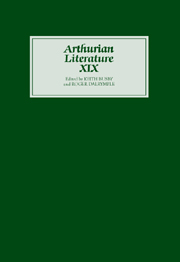Book contents
- Frontmatter
- Contents
- General Editor's Foreword
- I Comedy and Tragedy in Some Arthurian Recognition Scenes
- II Merveilleux et comique dans les romans arthuriens français (XIIe–XVe siècles)
- III La bande dessinée virtuelle du lion d'Yvain: sur le sens de l'humour de Chrétien de Troyes
- IV Convention, Comedy and the Form of La Vengeance Raguidel
- V Le comique dans Les Merveilles de Rigomer et Hunbaut
- VI Humour in the Roman de Silence
- VII La pratique de la ‘disconvenance’ comique dans le Lancelot en prose: les mésaventures amoureuses de Guerrehet
- VIII Lancelot Part 3
- IX Comic Functions of the Parrot as Minstrel in Le Chevalier du Papegau
- X Dinadan en Italie
- XI A Comical Villain: Arthur's Seneschal in a Section of the Middle Dutch Lancelot Compilation
- XII Malory and the English Comic Tradition
- XIII ‘Laughyng and Smylyng’: Comic Modalities in Malory's Tale of Sir Launcelot du Lake
- XIV The Eachtra an Amadáin Mhóir as a Response to the Perceval of Chrétien de Troyes
- CONTENTS OF PREVIOUS VOLUMES
XII - Malory and the English Comic Tradition
Published online by Cambridge University Press: 05 February 2013
- Frontmatter
- Contents
- General Editor's Foreword
- I Comedy and Tragedy in Some Arthurian Recognition Scenes
- II Merveilleux et comique dans les romans arthuriens français (XIIe–XVe siècles)
- III La bande dessinée virtuelle du lion d'Yvain: sur le sens de l'humour de Chrétien de Troyes
- IV Convention, Comedy and the Form of La Vengeance Raguidel
- V Le comique dans Les Merveilles de Rigomer et Hunbaut
- VI Humour in the Roman de Silence
- VII La pratique de la ‘disconvenance’ comique dans le Lancelot en prose: les mésaventures amoureuses de Guerrehet
- VIII Lancelot Part 3
- IX Comic Functions of the Parrot as Minstrel in Le Chevalier du Papegau
- X Dinadan en Italie
- XI A Comical Villain: Arthur's Seneschal in a Section of the Middle Dutch Lancelot Compilation
- XII Malory and the English Comic Tradition
- XIII ‘Laughyng and Smylyng’: Comic Modalities in Malory's Tale of Sir Launcelot du Lake
- XIV The Eachtra an Amadáin Mhóir as a Response to the Perceval of Chrétien de Troyes
- CONTENTS OF PREVIOUS VOLUMES
Summary
Malory's work is not usually considered one of the comic masterpieces of English literature; nevertheless, between the celebrations at the beginning and the elegies at the end, there are more comic moments than are usually recognized. There is, however, a sufficient number of such moments that allow us to read Malory as a key figure in the transmission of English comedy harking from the epic humor of Beowulf, to the wit and intricacy of eighteenth-century sentimental comedies, and even on to twentieth-century experiments in comic absurdity.
The immediate problem is the difficulty of determining Malory's sense of humor. Does he mean to be funny when we are amused? And why are we not amused by bits that seem to have made him giggle? As an example of the first difficulty, consider the elaborate quest in the form of a masque, the ‘straunge and […] mervailous adventure’ (63), Merlin prepares for Arthur's wedding feast. A white hart runs into the hall, followed by a ‘brachet’ and ‘thirty couple of blacke rennynge houndis’; the hart knocks over a knight who picks it up and leaves. Then a lady arrives on a white palfrey crying to Arthur to get her brachet back. Then a knight rides in and carries the lady away, although ‘ever she cryed and made grete dole’. And, then, Malory adds, ‘[s]o whan she was gone the kynge was gladde, for she made such a noyse’ (63).
- Type
- Chapter
- Information
- Arthurian Literature XIXComedy in Arthurian Literature, pp. 177 - 188Publisher: Boydell & BrewerPrint publication year: 2002



